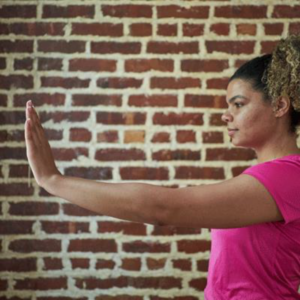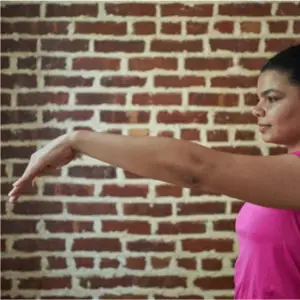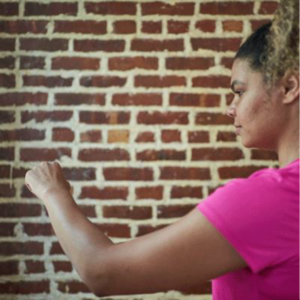By Gabrielle Kassel, August 20, 2020
August 20, 2020
Carpal tunnel syndrome, one of the most phonetically pleasing health conditions in the English language, affects the wrists. As many as 10 million Americans — that’s about 3 percent of the population — have some degree of this condition. Carpal tunnel can cause quite a bit of pain and discomfort, and considering how much we use our wrists in day-to-day life, it’s important to address this condition if it’s affecting your quality of life.
Stay tuned for the essential info, including five expert-approved exercises designed to help manage pain.
What is it, exactly?
Carpal tunnel syndrome happens when your median nerve, which runs along the underside of your forearm and up your hand through a tunnel of nine tendons called the carpal tunnel, gets squeezed or compressed. Experts aren’t totally sure what causes carpal tunnel, but one of the leading hypotheses is that it’s a type of anatomic compression and/or inflammation around the tendons.
Symptoms of carpal tunnel
There are many degrees of carpal tunnel syndrome, ranging from annoying to excruciating. Look out for these symptoms:
- Numbness, tingling, or jolts of pain in your thumb and first three fingers
- Pain that travels up and down your forearm
- Dull, constant, or even severe wrist pain
- New-onset grip weakness 5 daily exercises that might do the trick Before we get into the exercises, we should note that the first line of defense in managing carpal tunnel is determining that you actually have it. And the only way to do that is by seeing a professional.
How often should you do them?
The recommended scheme in the exercises below was set by the American Academy of Orthopedic Surgeons. However, Alejandro Badia, M.D., board-certified hand, wrist, and upper extremity orthopedic surgeon is adamant you speak with a healthcare provider before starting this regimen. And if you experience any sort of sharp pain, stop immediately.
1. Wrist extension stretch
Recommended reps: 5 Times per day: 4 Times per week: 5–7
“There’s some evidence that wrist extension and flexion exercises help widen the carpal tunnel a tiny little bit,” says Badia.
How to do it
1. Straighten arm and bend wrist so fingers are pointed up and
perpendicular to your forearm. (This should look like a “stop” sign.)
2. Use your opposite hand to apply pressure across your palm, pulling fingers toward you.
3. Hold for 15–30 seconds. Repeat on the other side.

2. Wrist flexion stretch
Recommended reps: 5 Times per day: 4 Times per week: 5–7
Surprise: The wrist flexion stretch is basically the exact opposite of the wrist extension stretch.
How to do it
1. Straighten arm and bend wrist down so palm is facing your body and fingers are pointed toward the floor, perpendicular to your forearm.
2. Use your opposite hand to pull fingers toward your body.
3. Hold for 15–30 seconds. Repeat on the other side.

3. Medial nerve glide
Times per day: 10–15 Times per week: 6–7
True to its name, this exercise is all about getting the nerve moving and grooving through some gentle thumb manipulation. Doctor of physical
therapy and founder of Just Move Therapy Dr. Marcia Darbouze, PT, DPT, adds this move is “awesome for relief.”
How to do it
1. Start with wrist in a neutral position, palm facing away from you, and fingers curled into a fist.
2. Open your fist into a flat palm, with thumb glued against pointer finger,
so wrist is parallel to the floor.
3. Bend wrist back toward you so the backs of your hand and fingers are facing your face.
4. “Unglue” thumb, extending it as far as you can away from palm.
5. Flip entire forearm so you’re now staring at palm and the underside of forearm
6. Use your other hand to gently pull down on thumb, giving it a nice stretch (but don’t pull too hard).
7. Repeat with the other hand.

4. Vertical tendon glides
Recommended reps: 5–10 Times per day: 2 or 3 Times per week: Daily
“Vertical and horizontal tendon gliding exercises really do seem to help people,” says Badia.
How to do it
1. Start with hand in “stop” position, wrist neutral, and fingers straight.
2. Bend fingertips toward the floor so they’re touching your palm. Hold for 3 seconds.
3. Curl fingers into fist, with thumb on the outside. Hold for 3 seconds.
4. Repeat with the other hand.

5. Horizontal tendon glides
Recommended reps: 5–10 Times per day: 2 or 3 Times per week: Daily
And last one…
How to do it
1. Start with hand in “stop” position.
2. Bend at bottom knuckle so fingers are perpendicular to palm. Hold for 3 seconds.
3. Touch fingertips to palm by hinging at middle knuckles. Hold for 3 seconds.
4. Repeat with the other hand
These exercises aren’t for everyone
According to physical therapist Lauren Jarmusz, these exercises may actually bring on some of your carpal tunnel symptoms.
She recommends doing 1 rep of each and waiting 10 minutes to see if your symptoms resolve. If the pain and discomfort don’t ease, discontinue the exercises and make an appointment to see your doctor.
What else can I do for my carpal tunnel?
The protocols will vary based on your pain level but could include any combo of the following:
Adjust your positioning
At your desk 8+ hours a day? The quickest remedy for folks whose symptoms are aggravated by their job is a desk makeover.
“Set up your workstation so that the monitor is eye level and an arm’s length away, the elbows are in line with the wrists, the mouse is nearby, the thighs are parallel to the floor, and the feet are planted,” suggests Darbouze.
Splints
“For early carpal tunnel syndrome, it’s very common for doctors to prescribe that a patient wear a splint at night,” says Badia.
Why at night? Because that’s when folks are most likely to knock their wrists in syndrome-exacerbating ways, he says.
He adds not to wear splints all day you because you can actually risk atrophying your wrist muscles.
Supplements and medication
Time to call on the old faithful NSAIDs. “The proper dosage of an over-the-counter anti-inflammatory with food before bed can help,” says Badia. Ditto before a day of answering emails.
He also regularly recommends a vitamin B6 supplement for folks with mild carpal tunnel syndrome. “Research has shown it functions like a physiologic diuretic, decreasing swelling around the nerve, and so I recommend supplementing with them.”
Acupuncture
“I’m an advocate for trying acupuncture with a Traditional Chinese Medicine doctor,” says Darbouze. “Search for community-based care or student intern clinics for more affordable options.”
Work with a physical therapist
Darbouze recommends seeking the care of a physical therapist. Physical therapy is far more than supervised exercise. “A great PT will help target the
weak muscles in the affected area and help you make them stronger, which can relieve symptoms.”
Surgery
We’re not going to sugarcoat it: Severe carpal tunnel requires surgery.
“If your carpal tunnel is really mechanically compressing median nerve, there’s really not a ton you can do to really and permanently relieve that pressure,” says Badia.
But don’t fret — apparently, as surgeries go, this one is a piece of cake.
“You can do it endoscopically,” Badia says. “So you’ll be able to use your hand right away, so long as you’re not handling anything super heavy.”
DIY ways to manage the pain
- Ice massages: Freeze water in a small paper cup and roll it over the underside of your wrists.
- Yoga targeting the wrists: This video incorporates many of the exercises we’ve discussed in this article.
Typing doesn’t actually cause carpal tunnel
This surprised us too.
“Saying typing causes carpal tunnel syndrome is like saying walking up two flights of stairs to your apartment causes knee arthritis,” says Badia. “If you already have knee arthritis, walking up the stairs every single day is going to hurt a heck of a lot more.”
Typing does make it worse, though
While typing can’t cause carpal tunnel, it can significantly worsen the symptoms, according to Jarmusz. “In the clinic, we advise patients to avoid more typing than they need. If they do have to type a lot, we suggest they use of a dictation software instead or, in last-case scenario, using a neutral wrist splint brace while typing (however, not all day, or atrophy will occur).”
As we mentioned, carpal tunnel is mainly caused by inflammation, which creates pressure on the median nerve. Common health issues that cause this inflammation are:
- diabetes
- thyroid dysfunction
- fluid retention from pregnancy or menopause
- high blood pressure
- autoimmune disorders like rheumatoid arthritis
- fractures or trauma to the wrist
In fact, because pregnancy and menopause commonly lead to carpal tunnel, people who are assigned female at birth are three times more likely to experience the syndrome.
When to see the doc
Badia recommends scheduling an IRL or telemedicine appointment with a healthcare provider if you’re experiencing any of the symptoms listed at the top of the article.
The provider will take your medical history and do a quick physical examination. This generally involves eyeballing your wrist for signs of swelling and distress and testing your grip strength.
The provider may also conduct a nerve conduction study, which measures how the nerve is functioned,” says Badia. The test itself is pretty simple. “The doctor will put little electrode sticky pads on your palm that measure how the median nerve is conducting electricity.”
He says the test can be a “little uncomfortable” and “pingy” but is usually not painful.
View the original publication below:
Related Articles:
-
Testimonial: Humerus Fracture in a Patient from Mexico
Juan Alberto Marrero Diaz shares his positive experience recovering from a humerus fracture after surgery at Dr. Badia’s outpatient center, highlighting excellent care and swift recovery.
-
Badia Hand to Shoulder Center Now In – Network for EVER Insurance Members
The Badia Hand to Shoulder Center now partners with EVER Insurance, providing members across Latin America and the Caribbean direct access to world-class care for upper-extremity conditions.
-
When and Why to Get a Second Opinion on Your Orthopedic Condition
Discover the importance of seeking a second opinion for orthopedic conditions to gain clarity, explore non-surgical options, and ensure you make the best treatment decision for your health and lifestyle.
-
Guide to Orthopedic X-rays, MRI, Ultrasound, and CT Scans
Discover essential insights into orthopedic imaging tests like X-rays, MRIs, ultrasounds, and CT scans to confidently navigate your diagnosis and treatment options.







